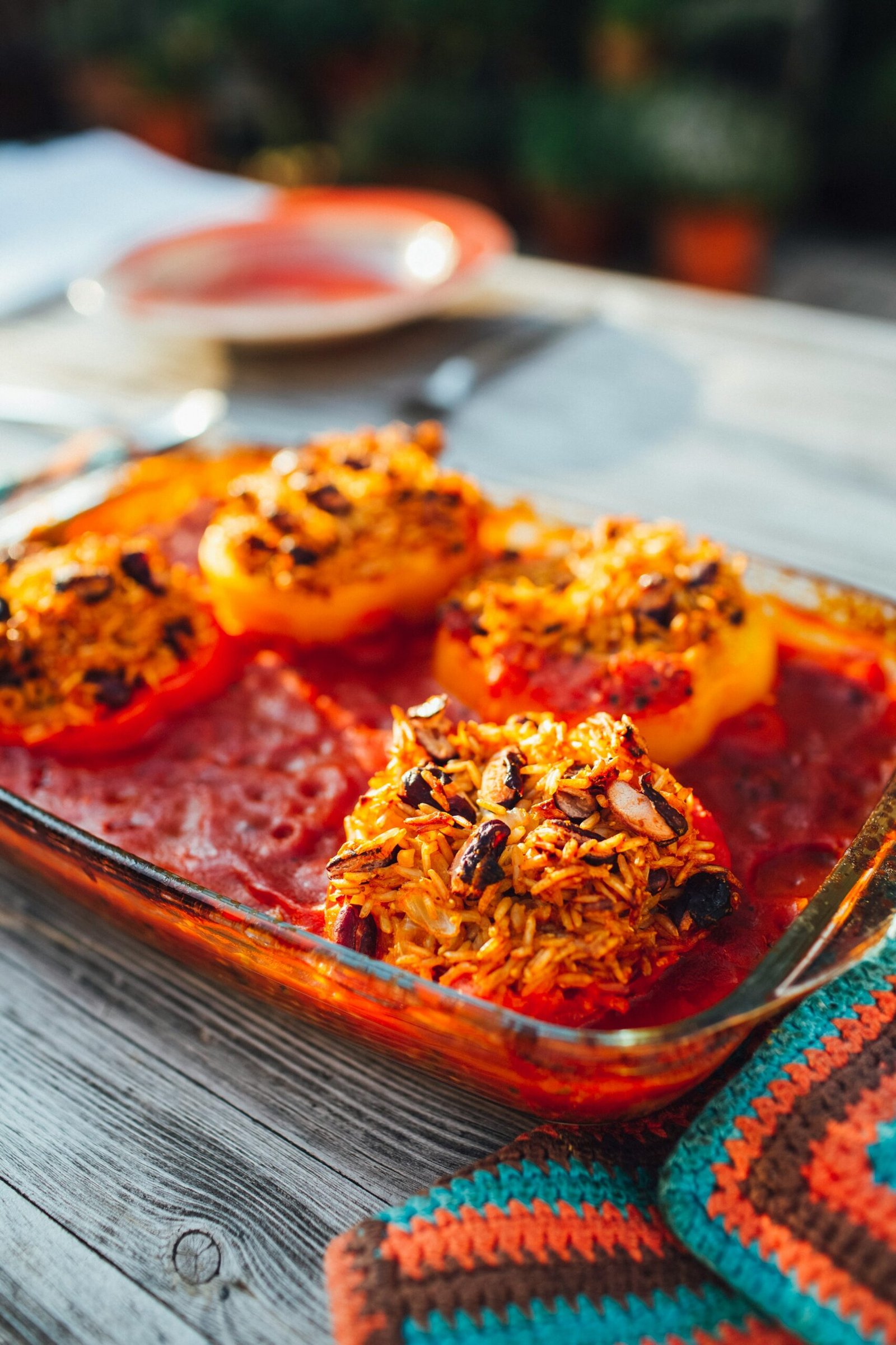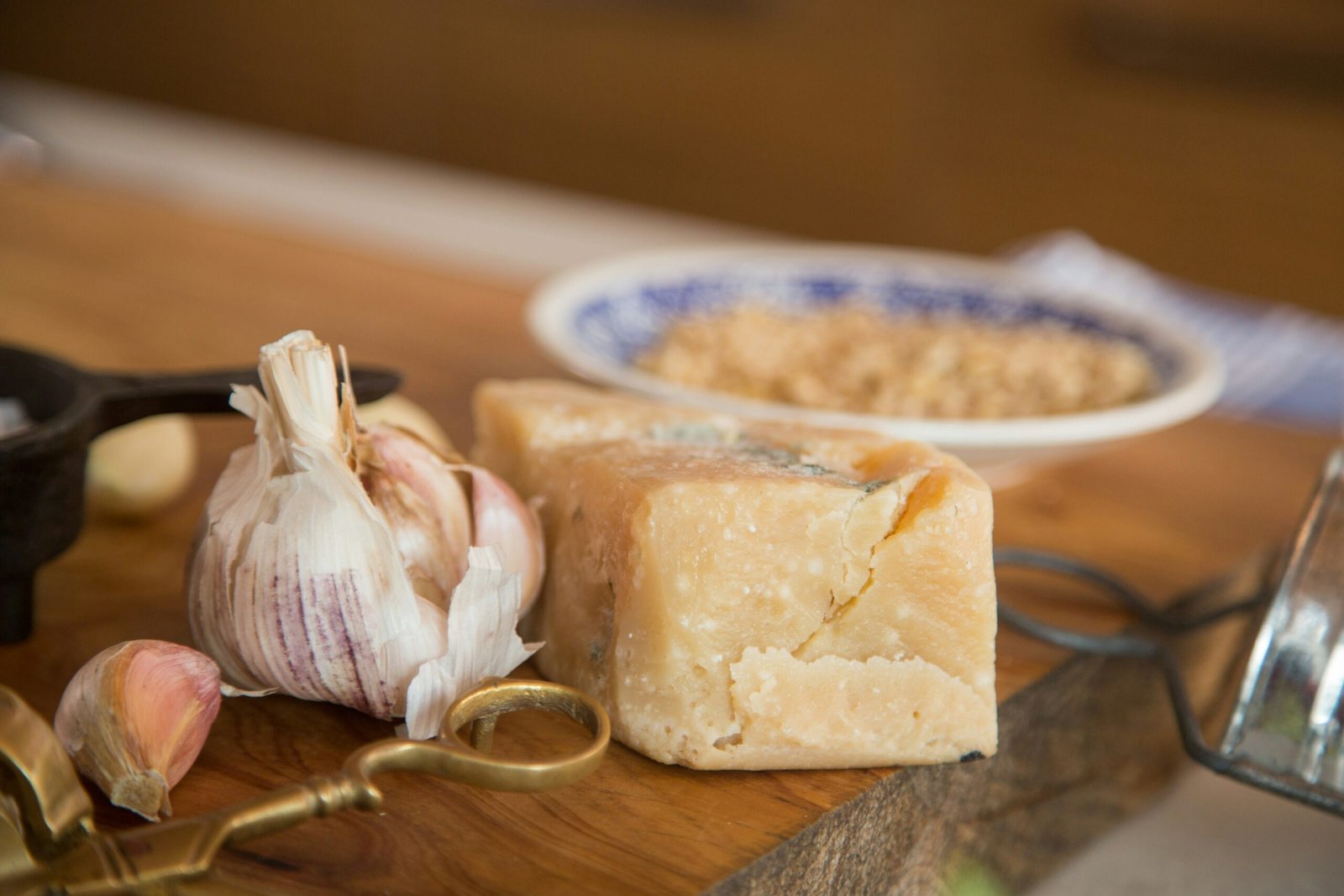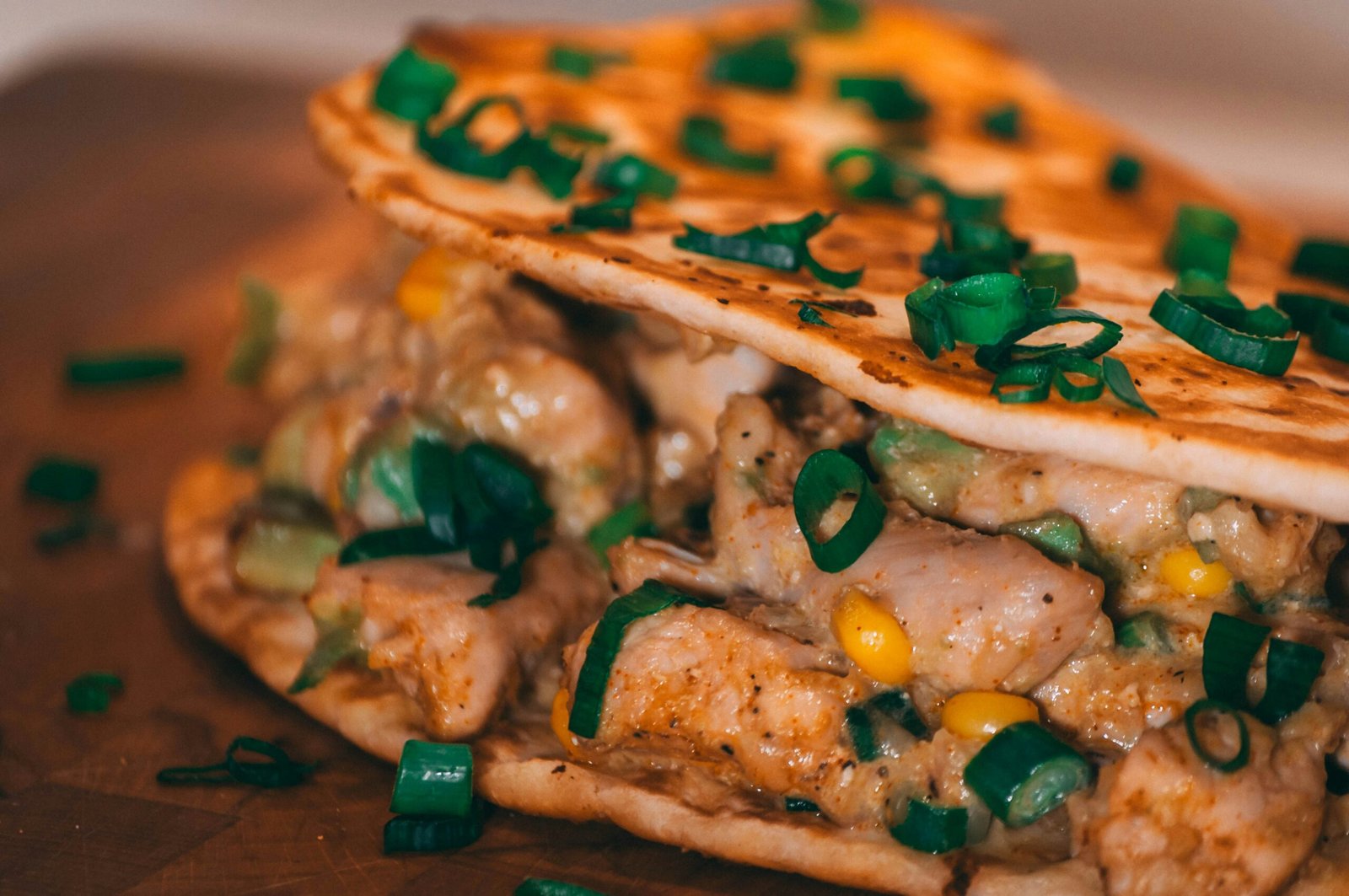Introduction to Stuffed Bell Peppers
Stuffed bell peppers are a timeless dish that brings together vibrant colors, delightful textures, and a plethora of flavors. These culinary marvels consist of bell peppers, which are hollowed and filled with various ingredients like rice, meat, beans, or vegetables, before being baked to perfection. The versatility of stuffed bell peppers makes them a favorite among home cooks, as they can be tailored to suit a myriad of taste preferences and dietary needs.
In terms of nutritional benefits, bell peppers are a powerhouse of vitamins and minerals. They are rich in vitamin C, vitamin A, and a range of antioxidants that support overall health. When stuffed with wholesome ingredients like lean proteins, grains, and legumes, they become a balanced meal that is both delicious and nourishing. This combination not only makes stuffed bell peppers an appealing option for health-conscious individuals but also ensures they are satisfying and hearty.
One of the standout features of stuffed bell peppers is their ability to act as a blank canvas for culinary creativity. Whether you prefer Mediterranean flavors with ingredients like feta cheese and olives, or you lean towards a more traditional filling with ground beef and tomatoes, the possibilities are endless. This adaptability makes stuffed bell peppers a versatile dish that can easily be adjusted to fit any occasion, be it a casual family dinner or a more formal gathering.
Moreover, stuffed bell peppers are not just a delight for the palate but also a feast for the eyes. Their colorful presentation can liven up any table setting, making them a crowd-pleaser at both everyday meals and special events. With their mixture of vibrant hues and rich flavors, stuffed bell peppers continue to be a beloved dish that highlights the joys of home cooking.
Ingredients You Will Need
To successfully prepare delicious stuffed bell peppers, you will need a variety of ingredients that contribute to the flavor, texture, and overall appeal of this dish. Here is a detailed list of essential ingredients along with optional additions for those looking to experiment with flavors:
Bell Peppers: The primary ingredient, bell peppers, serve as the edible vessels for the stuffing. Choose firm, vibrant peppers in red, yellow, orange, or green for a visually appealing plate.
Ground Meat: Ground beef, turkey, or chicken are commonly used to add protein and heartiness to the stuffing. For a vegetarian option, consider using crumbled tofu, lentils, or a meat substitute.
Onions and Garlic: These aromatic essentials enhance the savory profile of the stuffing. If you have dietary restrictions, onion powder and garlic powder can be used as substitutes.
Rice: Cooked rice, whether white, brown, or wild, acts as a binding element and offers a pleasant texture to the stuffing. Quinoa or couscous are excellent alternatives for those seeking variety or additional nutrients.
Cheese: Shredded cheese, such as mozzarella or cheddar, provides a creamy layer that melds the ingredients together. For a dairy-free version, opt for a plant-based cheese substitute.
Tomato Sauce: Tomato sauce or diced tomatoes add moisture and a tangy flavor to the stuffing mix. Marinara sauce or salsa can be used to introduce different flavor profiles.
Herbs and Spices: Common seasonings include salt, black pepper, paprika, and Italian herbs like oregano and basil. Fresh herbs such as parsley or cilantro can also be added for a burst of freshness.
Optional Additions: For those who wish to experiment, consider incorporating ingredients like black beans, corn, chopped spinach, or mushrooms for added texture and nutrients. Nuts and seeds, such as pine nuts or sunflower seeds, can also introduce a delightful crunch.
By understanding the role of each ingredient and making thoughtful substitutions, you can tailor this recipe to accommodate diverse palates and dietary needs, ensuring a delectable stuffed bell peppers experience for all.
Choosing and Preparing Your Bell Peppers
Choosing the right bell peppers is a crucial step in achieving a delicious stuffed bell pepper dish. Depending on personal preference and recipe requirements, bell pepper selection can vary in color, size, and firmness. Generally, the most suitable bell peppers for stuffing are those that are large, firm, and symmetrical. This ensures they can hold a generous amount of filling without collapsing or becoming overly soft during cooking.
When selecting bell peppers, pay attention to the color. While most stuffed bell pepper recipes do not specify a particular color, each color has its attributes. Red bell peppers are the sweetest, followed by orange and yellow, while green bell peppers have a slightly more bitter taste. Choose according to the desired flavor profile for your dish. Ensure that the bell peppers have smooth, blemish-free skins and feel heavy for their size, indicating freshness and juiciness.
Once you’ve selected your bell peppers, the preparation process begins. Start by washing the bell peppers thoroughly under running water to remove any residual dirt or pesticides. Then, using a sharp knife, carefully cut around the stem at the top of the bell pepper to create a lid. Remove the tops and set them aside if you plan to use them later as decorative caps for your stuffed peppers.
With the tops removed, gently insert a spoon into the opening to scrape out the seeds and membranes inside. It is essential to remove all the internal parts to clear out space for the stuffing and to ensure an even cooking process. Rinse the bell pepper interiors under running water to remove any remaining seeds. Lastly, inspect the bell peppers for any missed seeds or membranes and set them aside to dry.
Following these steps will prepare your bell peppers adequately for stuffing, allowing you to proceed with your recipe seamlessly. With properly selected and prepared bell peppers, you’re on your way to creating a delightful stuffed bell pepper experience.
Preparing the Stuffing Mixture
Creating the perfect stuffing mixture for your stuffed bell peppers begins with some basic yet essential steps. A popular starting point involves combining cooked rice and ground meat, which forms the core of a hearty, flavorful stuffing. Begin by cooking one cup of rice according to the package instructions. While the rice is cooking, sauté one pound of ground meat—beef, turkey, or chicken are all excellent choices—until it is fully browned. Drain any excess fat from the meat, allowing it to sit in a colander to remove moisture.
Next, focus on seasoning your stuffing mixture to elevate its flavor profile. Basic seasonings such as salt, pepper, garlic powder, and onion powder should be mixed into the ground meat. Aim for one teaspoon of each, adjusting to taste. Adding half a cup of chopped onions and minced garlic during the sautéing process can infuse your mixture with a richer, deeper flavor. Once your rice is ready and combined with the seasoned meat, your basic stuffing mixture is complete, perfect for beginners looking to master this classic recipe.
For those seeking to add an intermediate twist to their stuffed bell peppers, consider using quinoa instead of rice for a nutrient-dense alternative. Cook one cup of quinoa in vegetable broth to enhance its flavor before mixing it with your chosen ground meat. Grated vegetables such as zucchini or carrots can also be added for added texture and nutritional value. Incorporating a variety of spices, such as cumin, paprika, or oregano, can bring a more exotic essence to your stuffing. Vegetarians can substitute the meat with lentils or chickpeas to craft a delicious yet meat-free variation.
Achieving the best texture and flavor for your stuffing mixture involves a balance of moisture and seasoning. Ensure that your ingredients are not too wet, as this can lead to a soggy stuffing, nor too dry, which might result in a crumbly outcome. Adjusting the seasoning to your taste and allowing the stuffing mixture to rest for a few minutes before filling the bell peppers can enhance the final dish’s overall flavor and consistency. By following these steps and experimenting with different ingredients, you can create a stuffing mixture that caters to both beginners and more experienced cooks.
Stuffing and Assembling Your Peppers
Filling bell peppers with the prepared stuffing mixture is a critical step in achieving a delightful culinary experience. Begin by carefully holding each bell pepper upright. Utilize a spoon to scoop the filling mixture and gently place it inside the pepper, ensuring an even distribution. This approach prevents inconsistencies in taste and texture. Start by adding a small amount of stuffing at the base and gradually increase the quantity while occasionally tapping the pepper to settle the filling. Use a spoon or spatula to pack the filling gently but firmly, avoiding overfilling to prevent spillage during the cooking process.
When stuffing, take care not to press too hard, which could damage the delicate pepper walls. A slightly mounded peak at the top is ideal and visually appealing. If any filling mixture remains, it can be saved for another recipe or used as a side dish. Proper distribution within the peppers ensures that the flavors are well-balanced throughout each bite. Maintaining the structural integrity of the peppers is vital, especially when they begin to soften during baking.
After filling, place the stuffed bell peppers upright in a baking dish. Make sure they fit snugly to help them maintain their structure during the cooking process. Adding a small amount of water or broth to the bottom of the dish can keep the peppers moist and aid in creating a delicious, slightly steamy environment inside the oven. Covering the dish with aluminum foil for the first part of the baking process helps to evenly cook the stuffed peppers. Removing the foil later allows the tops to become golden-brown and slightly crispy, enhancing both the texture and the presentation of the finished dish.
Baking Your Stuffed Bell Peppers
Ensuring your stuffed bell peppers are perfectly baked is critical to achieving a flavor-infused, tender dish. To begin, preheat your oven to 375°F (190°C). This temperature strikes a balance between thoroughly cooking the filling and keeping the peppers firm yet tender. Place your stuffed peppers in a baking dish, ensuring they are evenly spaced to allow uniform cooking.
Cover the peppers loosely with aluminum foil to prevent them from drying out during the initial baking stage. Bake them for approximately 35 to 40 minutes, depending on the size of the peppers and the density of the filling. To check for doneness, use a fork or knife to pierce the peppers gently. They should yield easily without being overly soft, indicating that they are cooked through but still holding their shape.
For a richer flavor and a crisp, golden topping, consider adding cheese during the final stages of baking. Uncover the peppers, sprinkle shredded cheese such as mozzarella, cheddar, or Parmesan on top, and return them to the oven for an additional 10 minutes. This step will allow the cheese to melt and develop a delightful crust, enhancing the overall texture and taste of the dish.
Besides cheese, you can also experiment with other toppings like breadcrumbs mixed with herbs or a light drizzle of olive oil to add an extra layer of flavor. Regardless of the toppings you choose, be mindful to monitor the peppers frequently during the final bake to prevent overbrowning.
Finally, once your stuffed bell peppers have reached the desired level of doneness, remove them from the oven and let them rest for a few minutes before serving. This resting period allows the juices to redistribute evenly, ensuring each bite is as flavorful and satisfying as the last.
Serving Suggestions and Variations
Stuffed bell peppers offer a versatile and satisfying meal option that can be tailored to complement various cuisines and food preferences. To elevate your stuffed bell peppers, consider pairing them with an assortment of side dishes and sauces. A crisp garden salad or a bowl of quinoa can balance the rich stuffing, while a drizzle of homemade tomato sauce or a dollop of Greek yogurt adds a pleasant acidity and creaminess to each bite. For a more robust accompaniment, garlic bread or a side of roasted vegetables can also be excellent choices.
Creative variations allow you to keep the dish exciting and adaptable to different tastes and dietary needs. For a meatless option, you can replace the traditional ground meat stuffing with a blend of legumes and grains such as lentils, chickpeas, or quinoa, providing ample protein and texture. Alternatively, consider a seafood twist by incorporating shrimp or crab into the stuffing.
Diversifying the types of peppers used can also introduce new flavors and levels of heat to the dish. Bell peppers are naturally sweet and mild, but using poblano or Anaheim peppers can add a subtle spice, while cherry peppers deliver a stronger punch for those who enjoy heat. This mix-and-match approach to peppers can cater to various palates at the dining table.
Adapting the recipe for specific dietary needs is straightforward with stuffed bell peppers. For a gluten-free version, ensure that any grains used are certified gluten-free, or swap them for cauliflower rice. To cater to low-carb or keto diets, minimize carbohydrate-rich ingredients and center the stuffing around cheese, meats, and low-carb vegetables. Vegan variations can be achieved by using plant-based proteins and dairy substitutes such as tofu or vegan cheese.
Whether sticking to a classic recipe or exploring new twists, serving stuffed bell peppers with complementary sides and considering varied stuffing ingredients will ensure a nourishing and delightful meal for all guests.
Troubleshooting and FAQs
Cooking stuffed bell peppers can sometimes present challenges, even for those with some kitchen experience. One frequent issue is overly soft peppers. This often occurs when peppers are cooked for too long or at too high a temperature. To avoid this, be sure to monitor cooking times carefully and consider partially cooking the peppers before stuffing them to ensure they maintain their structure.
Dry stuffing is another common problem. This can typically be remedied by adjusting the moisture content of your filling. Adding a bit more liquid, such as broth or tomato sauce, during the preparation of the stuffing can help keep it moist. Additionally, mixing in ingredients like cheese or breadcrumbs can help retain moisture without making the stuffing too wet.
Frequently, readers have questions about ingredient substitutions. For example, if you’re looking to reduce carbohydrate intake, consider using a cauliflower rice mixture in place of traditional rice. Similarly, to make the dish vegetarian, substituting beans or lentils for ground meat is an excellent option.
Another common inquiry involves the cooking method. Some wonder if it’s possible to use an air fryer instead of a traditional oven. The answer is yes, but adjustments may be required. Air frying can reduce cooking time, so be vigilant to avoid overcooking.
Storage and reheating are also frequent topics of interest. Stuffed bell peppers can be stored in an airtight container in the refrigerator for up to four days. For reheating, using an oven ensures even warming without making the peppers soggy.
Lastly, concerns about seasoning often arise. If finding the right balance of spices proves challenging, starting with a basic seasoning of salt, pepper, and garlic, then gradually introducing herbs like basil or oregano to taste, is a good strategy. This approach allows for adjustments based on personal preference and can significantly enhance the overall flavor profile of the dish.














